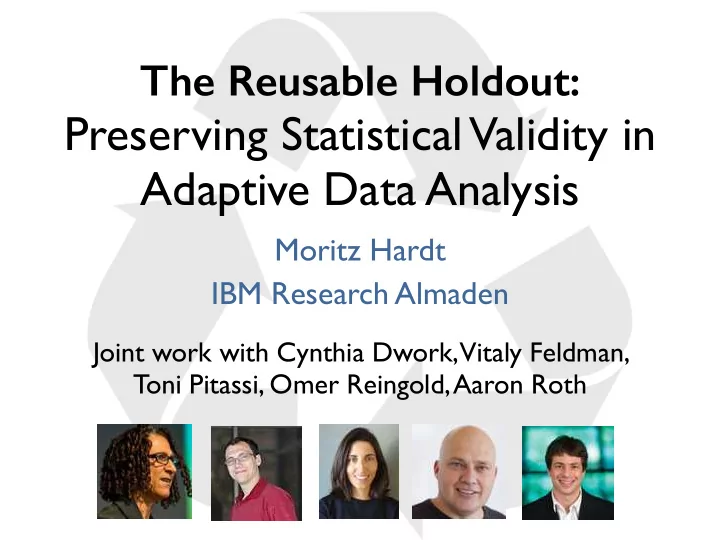

The Reusable Holdout: Preserving Statistical Validity in Adaptive Data Analysis Moritz Hardt IBM Research Almaden Joint work with Cynthia Dwork, Vitaly Feldman, Toni Pitassi, Omer Reingold, Aaron Roth
False discovery — a growing concern “Trouble at the Lab” – The Economist
Most ¡published ¡research ¡findings ¡ ¡ are ¡probably ¡false. ¡ ¡ – ¡John ¡Ioannidis P-‑hacking ¡is ¡trying ¡multiple ¡things ¡until ¡you ¡get ¡the ¡ desired ¡result. ¡– ¡Uri ¡Simonsohn She ¡is ¡a ¡p-‑hacker, ¡she ¡always ¡monitors ¡data ¡while ¡it ¡is ¡ being ¡collected . ¡– ¡ Urban ¡Dictionary ¡The ¡p ¡value ¡was ¡never ¡meant ¡to ¡be ¡used ¡the ¡way ¡it's ¡ used ¡today . ¡– ¡ ¡Steven ¡Goodman ¡
Preventing false discovery Decade old subject in Statistics Powerful results such as Benjamini-Hochberg work on controlling False Discovery Rate Lots of tools: Cross-validation, bootstrapping, holdout sets Theory focuses on non-adaptive data analysis
Non-adaptive data analysis • Specify exact experimental setup • e.g., hypotheses to test • Collect data • Run experiment Data • Observe outcome analyst Can’t ¡reuse ¡data ¡ ¡ after ¡observing ¡outcome.
Adaptive data analysis • Specify exact experimental setup • e.g., hypotheses to test • Collect data • Run experiment Data • Observe outcome analyst • Revise experiment
Adaptivity Data dredging, data snooping, fishing, p-hacking, post-hoc analysis, garden of the forking paths Some caution strongly against it: “Pre-registration” — specify entire experimental setup ahead of time Humphreys, Sanchez, Windt (2013), Monogan (2013)
Adaptivity “Garden of Forking Paths” T he most valuable statistical analyses often arise only after an iterative process involving the data — Gelman, Loken (2013)
From art to science Can we guarantee statistical validity in adaptive data analysis? Our results: To a surprising extent, yes. Our hope: To inform discourse on false discovery.
A general approach Main result: The outcome of any differentially private analysis generalizes*. * If we sample fresh data, we will observe roughly the same outcome. Moreover, there are powerful differentially private algorithms for adaptive data analysis.
Intuition Differential privacy is a stability guarantee: • Changing one data point doesn’t affect the outcome much Stability implies generalization • “Overfitting is not stable”
Does this mean I have to learn how to use differential privacy? Resoundingly, no! Thanks to our reusable holdout method
Standard holdout method training data unrestricted access Data holdout good for one Data validation analyst Non -‑reusable: ¡Can’t ¡use ¡information ¡from ¡ ¡ holdout ¡in ¡training ¡stage ¡adaptively
One corollary: a reusable holdout training data unrestricted access Data reusable holdout can be used Data many times analyst adaptively essentially as good as using fresh data each time!
More formally Domain X. Unknown distribution D over X Data set S of size n sampled i.i.d. from D What the holdout will do: Given a function q : X ⟶ [0,1], estimate the expectation 𝔽 D [ q ] from sample S Definition: An estimate a is valid if | a − 𝔽 D [ q ]| < 0.01 Enough for many statistical purposes, e.g., estimating quality of a model on distribution D
Example: Model Validation f We trained predictive model f : Z ⟶ Y and want to know its accuracy Put X = Z × Y. Joint distribution D over data x labels Estimate accuracy of classifier using the function q ( z , y ) = 1 { f ( z ) = y } 𝔽 S [ q ] = accuracy with respect to sample S 𝔽 D [ q ] = true accuracy with respect to unknown D
A reusable holdout: Thresholdhout Theorem. Thresholdout gives valid estimates for any sequence of adaptively chosen functions until n 2 overfitting* functions occurred. * Function q overfits if | 𝔽 S [ q ] - 𝔽 D [ q ] | > 0.01. Example: Model is good on S , bad on D .
Thresholdout Input: Data S , holdout H , threshold T > 0 , tolerance σ > 0 Given function q : Sample η , η ’ from N(0, σ 2 ) If | avg H [ q ] - avg S [ q ] | > T + η : output avg H [ q ] + η ’ Otherwise: output avg S [ q ]
An illustrative experiment • Data set with 2 n = 20,000 rows and d = 10,000 variables. Class labels in {-1,1} • Analyst performs stepwise variable selection: 1. Split data into training/holdout of size n 2. Select “best” k variables on training data 3. Only use variables also good on holdout 4. Build linear predictor out of k variables 5. Find best k = 10,20,30,…
No correlation between data and labels data ¡are ¡random ¡gaussians ¡ ¡ labels ¡are ¡drawn ¡ independently ¡at ¡random ¡from ¡{-‑1,1} Thresholdout ¡correctly ¡detects ¡overfitting!
High correlation 20 ¡attributes ¡are ¡highly ¡correlated ¡with ¡target ¡ remaining ¡attributes ¡are ¡uncorrelated Thresholdout ¡correctly ¡detects ¡right ¡model ¡size!
Conclusion Powerful new approach for achieving statistical validity in adaptive data analysis building on differential privacy! • Reusable holdout: • Broadly applicable • Complete freedom on training data • Guaranteed accuracy on the holdout • No need to understand Differential Privacy • Computationally fast and easy to apply
Go read this paper for a proof:
Thank you.
Recommend
More recommend